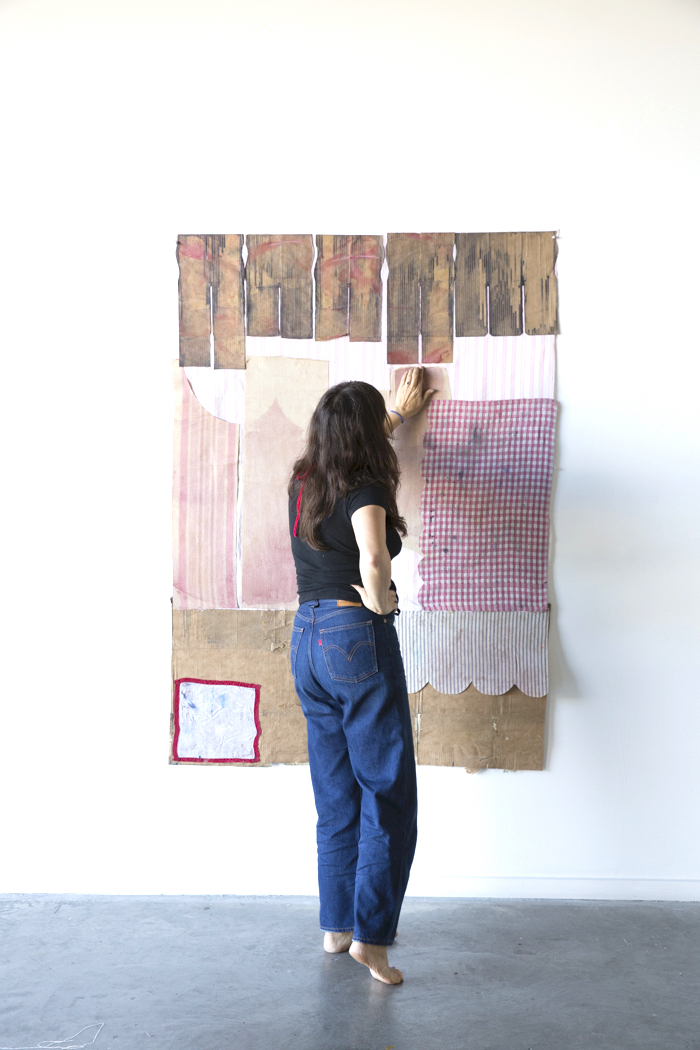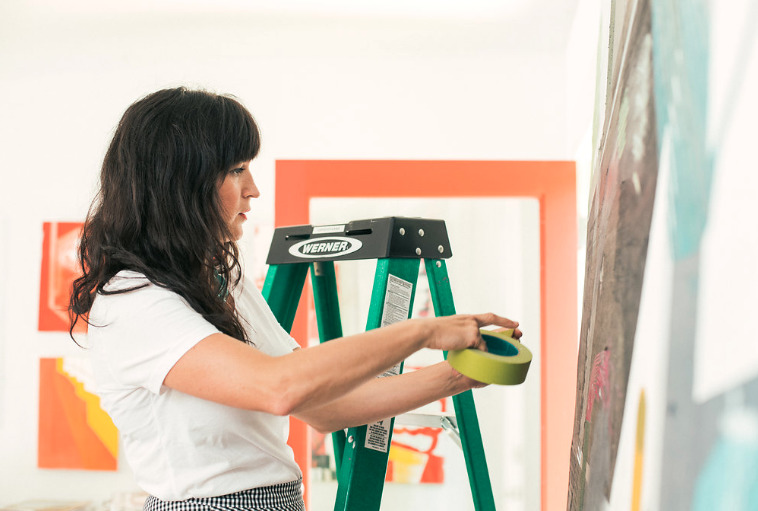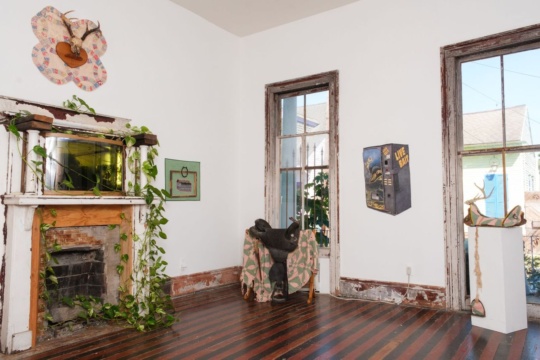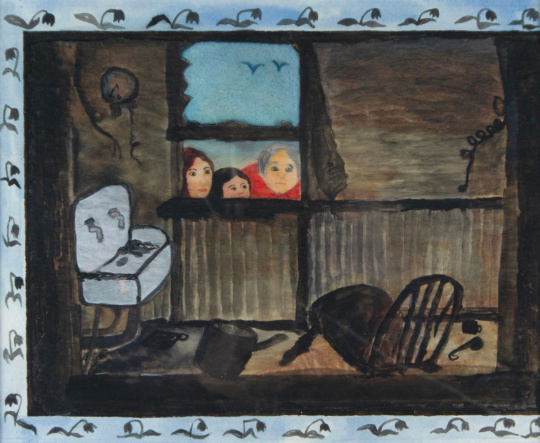
Nashville-based artist Jodi Hays usually moves among several paintings in her studio practice, a habit that may be responsible for echoes across her body of work. Yet each painting stands on its own as bold and intense, a carefully wrought yet experimental playing with composition and form. I’ve long been drawn to Hays’ paintings, which are rendered with palette knives, tape, and other exacting tools. I sometimes read them as abstract cityscapes, full of sharp angles, architectural forms, and geometrical shapes. She envisions herself as part of the lineage of painting and is moved to investigate restraint and abandon by slipping between abstraction and representation. She implies fences and walls as metaphors for the limits of physical and psychological spaces.
But there is also something very human in this work that speaks to our relationships with our immediate environments. The screen-like stripes and overlaid grids act as borders, actual and metaphorical, in modern life. Hays’ paintings have an internal logic that I could study for years. This speaks to her striking instinct for composition that’s magnified by her disciplined practice, but also to her sharp, critical mind.
Last year, Hays opened a pop-up gallery in her backyard studio called DADU (short for Detached Accessory Dwelling Unit, the city code name for structures on one’s property). I visited the unit in between DADU exhibitions to talk to Hays about her new series called The Devil’s Neighbor.

Erica Ciccarone: Your work often uses grids, adhering to them, subverting them, playing with them as limits, and a lot of your work has a kind of architecture to it that I really love. Why are you drawn to grids and urban landscapes?
Jodi Hays: Landscape had been a consistent touchstone in my work—sometimes overtly, sometimes not—perhaps related to having almost literally grown up in a National Park. Living in cities for my adult life, I began to collect images of construction sites that I could then isolate to speak to disparate issues of time, upheaval, restraint, abandon, and progress. The grid’s history is richly connected to land through surveying. I also like to push against the use of the grid as a tool of perspective.
EC: I suspect people might call you a “painter’s painter” (which has always struck me as a silly label). But the way you build and take away context in your paintings strikes me as way of commenting on the medium. Do you think there’s any truth to that?
JH: When I chose to paint, part of that choice was for painting’s ability to comment on itself and to leverage the overlap of painting’s properties with the preoccupations on my practice—artifice, time, landscape references, grids, and structure. I see my work couched in a moment in which there is less doubt, less angst, and more hope.
EC: Let’s talk about your new series, The Devil’s Neighbor. Your paintings and series always have really intentional and beautiful titles. Where does that title come from?
JH: The new work The Devil’s Neighbor is also called Winter Papers because they happened on my dining room table in the winter, perhaps tapping into an intimacy of scale and thought. They’re informed by using the stripe—a device of pattern and a lead character in my iconography—as a standard or element of the grid. The paintbrush has its own width or measure, setting up a logic on the paper. With these small works, I was seeing what happens when the stripe or grid sags or sways. I began to think about the grid as relative to a “devil”—this metaphorical or actual standard of bad or evil. The guy who lives next door to the devil is his neighbor, not conditioned with a label, but complicit nonetheless because of proximity, like lines parallel on a page.
I was interested in extending painting metatags through our current heavy and intense political climate. Last summer saw the migrations across Europe, police/public conflict, and the South Carolina flag controversy. The work is formal, but informed by processing—or perhaps remembering—events happening both on local and global levels.
In the end, it made sense that all of that would surface into the work. The work is not about migrants or the public’s relationship to police, but the works are dependent on a grid system (laws, leaders, police) and then the system bending, yielding and being interrupted (protests, revolts, moves). The work is still the work, and formal, yet I can sense some of the gray and darkness was informed by the world around me.
Titles are a toehold, a way to create a snag in the fabric of the work, for both me and the viewer. I keep titles on my iPhone in a note now but used to keep notebooks of lists. At one point I had a cigar box full of post-its. They are culled from my reading, soundbites, anything, but have to function on two levels: to comment on the medium of painting—a wide girth—and be rooted in personal directive. [cont.]
EC: I’m going to make the most obvious observation ever right now: The Devil’s Neighbor is much darker than, say, your work from 2014-15, which had a more decorative palette and feels more sensual. Were you surprised when you found yourself working with a dark, more muted palette? What’s behind that?
JH: Actually, the entrance of color after a long run of monochrome was more surprising to me than the dark/muted turn. There’s so much of the gray out on the world, literally and figuratively. My favorite color is Payne’s Gray. I love a good grisaille. The color was a really hopeful, bright surprise, like when I first saw a Joanne Greenbaum painting.
EC: We’ve talked in the past about the individual language of painters. How would you describe your own?
JH: My iconography includes stripes, lines often lifted from grids, fences, and tactile shapes, sometimes recognizable as a representation of something, sometimes not.
EC: You’ve said while making The Devil’s Neighbor paintings, you’ve been thinking about parables. Parables hope to teach spiritual lessons, and for me, this past year in America has shown us to be pretty sick in spirit. Are parables a part of your family or personal history? Why are they showing up in your work?
JH: Jesus’ parables, in particular, have been one directive among many as a delivery system in language and storytelling that both confounds as it attempts to reveal. In the Gospels, Jesus is always saying, “The Kingdom of Heaven is like …” usually followed by something that sounds neither kingdomlike nor heavenlike … money, mustard seeds, cranky entitled sons.
Since I am interested in a position of painting that adds to a conversation on confusing structures (like figure/ground, for instance), this kind of influence did seem as far out in left field as it did on first glance. I grew up around story as the condition of Southern folk–oral histories, dark narrative, and accents. Often this has strictly shown up in titles. This kind of way to pack, or unpack, is relevant to my interest in the grid and stripes as camouflage and hiding and revealing. This struck me as what my favorite paintings can do—confound and complexify.
There is certainly a lot of “sick in spirit.” Always has been. Painting is declared dead again and again. But I also see a lot of good and life. I have to.
EC: Are there any themes that come back into your work, once you thought you were done with them?
JH: I suppose the new works are reemphasizing some works in less overt ways from ten years ago that were specifically about isolation and community. But, looking back, the work has always been an effort to process the world.
EC: I am curious about how the intuition about form and composition might translate to addressing social problems. Can you speak to that?
JH: To quote Greg Bordowitz, “I still think that art can change the world.” What if we all approached issues with the reverence, thought, and discipline that I see my favorite artists employ? I am for lawmakers, neighbors, police officers, students, artists, and churchgoers who can sustain a conversation and take responsibility without defense, which is incredibly hard—for me, for all of us–but a hope worth working towards. Exactly like painting—making your small mark in the midst of a larger world, fraught with decay or cynicism—that’s hopeful.
The work is not about migrants or the public’s relationship to police, but the works are dependent on a grid system (laws, leaders, police) and then the system bending, yielding and being interrupted (protests, revolts, moves). The work is still the work, and formal, yet I can sense some of the gray and darkness was informed by the world around me.
EC: What have you been reading these days?
JH: I am reading a lot of essay these days, as I have been teaching grad students on and off, so relevant articles like Christopher Hall’s “Moving Towards Metamodernism” that was published in BURNAWAY recently, and other art blogs: Two Coats of Paint, Hyperallergic, Gorky’s Grandmother, Modern Art Notes, Bad at Sports, Painter’s Table, Art F City … I also just finished Ta-Nehisi Coates’ Between the World and Me, am always working through Agnes Martin: Her Life and Art by Nancy Princenthal, and parables.
EC: What advice would you give someone who is learning how to read a painting?
JH: Decide on one gallery to visit often, say, six times in a year. Say to yourself out loud what you see in a painting–what formal elements and images. Give the artist some credit, trust their gut and their research.
Jodi Hays’s work is included in “BEVY 2016″ at Julia Martin Gallery (through July 31), and University of Tennessee, Knoxville’s alumni show of Nashville painters, titled “Encore” (July 5 – August 28).




